Even pretty staggering changes in the natural world can struggle to compete for attention amid the cacophony of modern media and cage-fighting politics (which of course can concern many other topics relevant to human well-being, on top of a near-infinite capacity for distraction).
In our window of time here and on our watch, we’re observing the unfolding collapse of global coral reef cover – the largest living structures on the planet, relatively priceless in terms of human and economic value, and stunningly beautiful – due to human-induced stresses, now most prominently from human-caused global anthropogenic (greenhouse) warming of the oceans.
Some articles in major media break through, e.g. Global Warming’s Toll on Coral Reefs: As if They’re ‘Ravaged by War’, though the impact on public awareness and policy action remains low. The impact is global including the Great Barrier Reef (GBR), Japan, the South Pacific, Hawaii, the Florida keys, and Belize.

Naturally thinking about such things is hard, and for many – unfortunately including currently in power political parties drafting environmental policy – this dramatic plight of corals is already enjoying far too much attention. They feel the problems are likely exaggerated or contrived to justify policy actions around reducing greenhouse gas pollution. “Coral alarmism”.
Mass Bleaching
Having a skeptical orientation, I’ve engaged with science-disputing claims online for years. I noticed some comments on a U.K. science-disputing web site along these lines – “RIP beautiful coral reefs. (sniff, sniff, *reaches for Kleenex*)” – and had a discussion with the locals, then decided to post and expand on the response here.
What’s happening? In a nutshell, the main cause of the observed escalation of mass bleaching and coral death is heat stress. When temperatures are elevated above previously normal seasonal peaks for extended periods of time, coral bleaches (expel symbiotic algae). If it stays bleached long enough, it can die from the coral equivalent of asphyxiation.
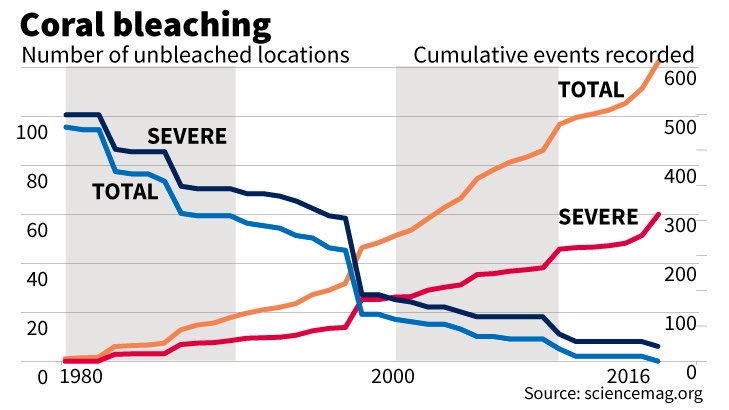
The relationship with ocean temperature is fairly direct. Scientists now closely monitor temperature and bleaching risk (from Heron et al 2016):
Satellite monitoring of thermal stress on coral reefs has become an essential component of reef management practice around the world. A recent development by the U.S. National Oceanic and Atmospheric Administration’s Coral Reef Watch (NOAA CRW) program provides daily global monitoring at 5 km resolution—at or near the scale of most coral reefs… Analysis of coral community characteristics, historical temperature conditions and thermal stress revealed a strong influence of coral biodiversity in the patterns of observed bleaching. This resulted in a model based on thermal stress and generic richness that explained 97% of the variance in observed bleaching.
Since the core driving factor is water temperature, it’s pretty easy to see how the growing scale of bleaching is directly tied to global (ocean) warming. And in fact it’s pretty straightforward to show this statistically.
Mass… El Niño?
But facing human-driven problems on this scale is hard emotionally – what do you do if you don’t want this to be true?
Well we could look to blame big weather system events. And there is one in particular that attracts our attention right away – all tropical storms bow before El Niño.
Global El Niño (weather) conditions elevate surface ocean temperatures in a multi-month oscillating pattern (the “O” in ENSO). So blaming the bleaching on El Niño has been one of the more common (frequently absurd) contrarian responses, as in this case.
Our blogger, Jaime Jessop, opens by casually assuming that since mass bleaching was “first recorded during warmer than average El Niño conditions”, El Niño is the key. And a-ha – “there have only been three recorded ‘very strong’ or super El Niño events since 1950”, so how can we say if such bleaching is unusual or not? Of course there were strong El Nino events in 1957, 1966 and 1972 too, and by recent times mass bleaching recorded under quite mild El Niño conditions in 2002 and 2005, but it’s not really necessary to discuss in this detail.
A more significant problem with this theory is that the most recent mass bleaching on the GBR (spring of 2017 – 20% or more total mortality per GBRMPA) happened under ENSO Neutral conditions, rather than El Niño. So… whoops.
Jessop cites a Guardian article noting that mass bleaching is now happening independently of El Niño, and indulges in some misplaced indignation:
“Any time”? That would imply that mass coral bleaching is occurring randomly regardless of El Niño events. This is clearly double Dutch from the Guardian
It ain’t “double dutch”. El Niño events encourage more pooling of warm water on the surface, especially in some parts of the Pacific, which is why we tend to see new temperature peaks in such conditions. But it is simply elevated water temperature that is choking off coral.
The total oceans have warmed such that sustained regional high temperature conditions are more common even under ENSO Neutral (and La Nina) conditions. This is reasonably straightforward; disputing it would require competing physical explanations and supporting evidence.
The Science of Escalating Impact
Readers will be familiar with two CO2-related threats to coral – ocean warming (from the anthropogenic pollution of greenhouse gases in the atmosphere) as well as ocean acidification. The latter is a separate topic that impacts the productivity of calcium carbonate skeleton/reef construction (implicated in longer term reef gaps in earth’s past). The mass bleaching die-offs we’re seeing in the last few years are simply a direct result of the former – the increase in the water temperature in which coral are immersed.
Intuitively, many people feel it is unlikely for coral to be so heavily impacted by the mere 1°C (~2°F) increase in average temperature that has happened globally so far – partially because as land creatures we are biased to think in terms of air temperature where there is much less effect from small changes in temperature (air being less dense.)
A more useful mental experiment might be to imagine the impact of a sustained full 2°F increase in your body temperature, or of how much longer you could survive submerged in a hot tub at 105°F vs. 107°F.
To start, bleaching via thermal stress is lab reproducible and uncontroversial. If you’re curious, see Jones et al 1998, “Temperature-induced bleaching of corals begins with impairment of the CO2 fixation mechanism in zooxanthellae”.
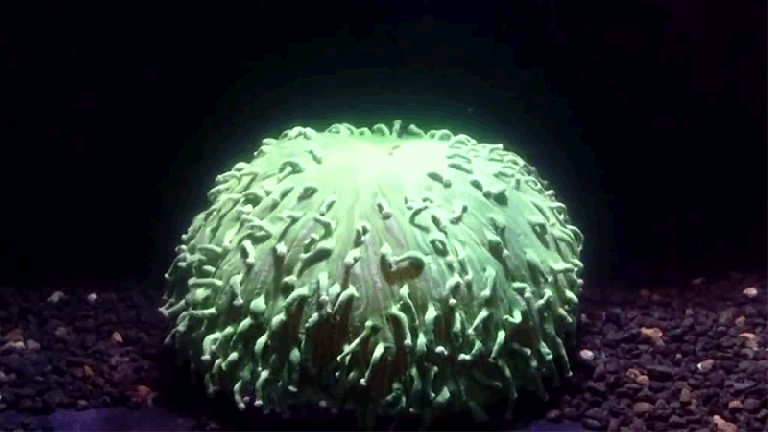
Timelapse of zooxanthellae explusion, coral bleaching
Reef experts have been warning about risks for some time, well before the major mortality events of 2016 and 2017. The topic is hardly new or contrived for political purposes. Reaser et al 2000, reviews some of the history of research attention in “Coral Bleaching and Global Climate Change: Scientific Findings and Policy Recommendations”:
Nearly 80 years ago, Alfred Mayer described coral bleaching as a natural event, when he observed small scale bleaching in overheated tide pools (Goreau & Hayes 1994). Because the events were rare, localized, and corals typically recovered, bleaching events caused little concern … in the early to mid 1980s, however, coral reefs around the world began to experience large scale bleaching (Goenaga & Canals 1990; Goreau 1990; Williams & Bunkley-Williams 1990; Glynn 1991; Hayes & Goreau 1991; Goreau 1992; Glynn 1996; Brown 1997) … Corals have died throughout entire reef systems following mass bleaching events … Recovery of coral reefs is dependent on numerous factors, including the local severity and duration of thermal stress … recovery to previous levels of coral cover … could take decades to possibly hundreds of years. Some corals have survived the mass extinctions brought on by natural climactic variabilities in the past (e.g. 75,000 years ago). Because of the rapid rate at which significant climactic changes could now proceed, however, the ability of most corals to acclimatize, migrate, or adapt is uncertain and unsubstantiated (see discussion by Hoegh-Guldberg 1999). … Hoegh-Guldberg (1999) examined four predictive climate-change models to project the increasing severity of mass coral bleaching events. All four models confirmed the same trends: the frequency of bleaching will rise rapidly… within 3-5 years most regions will experience mass bleaching annually.
The Global Coral Reef Monitoring Network, an international network of marine ecologists and organizations organized around practical efforts to monitor and conserve reefs, highlighted the growing threat from climate change in its summary report “Status of Coral Reefs of the World: 2008”
current rates of climate change pose the greatest threat to the long-term sustainability of coral reefs and human coastal communities
Another example paper, Berkelmans et al 2004, described the growing scale of bleaching events on the Great Barrier Reef in 1998 and 2002 and noted the likelihood of future “large declines” under continued warming:
Since 1979, the number, scale, and intensity of reported coral bleaching events has grown dramatically and this trend has been linked to climate change… results suggest that coral reefs are profoundly sensitive to even modest increases in temperature and, in the absence of acclimatization/adaptation, are likely to suffer large declines under mid-range International Panel for Climate Change predictions by 2050
Researchers apply modeling to better estimate the extent of carnage under the most likely ocean warming trends. Frieler et al 2013 uses general circulation models to provide the alarming warning that “Limiting global warming to 2 °C is unlikely to save most coral reefs“
We show that preserving >10% of coral reefs worldwide would require limiting warming to below 1.5 °C (atmosphere–ocean general circulation models (AOGCMs) range: 1.3–1.8 °C) relative to pre-industrial levels
And finally, the Intergovernmental Panel on Climate Change (IPCC) Fifth Assessment Report summarized these projections starkly:
Coral reefs within CBS, SES, and STG are rapidly declining as a result of local stressors (i.e. coastal pollution, overexploitation) and climate change (high confidence). Elevated sea temperatures drive impacts such as mass coral bleaching and mortality (very high confidence), with an analysis of the Coupled Model Intercomparison Project Phase 5 (CMIP5) ensemble projecting the loss of coral reefs from most sites globally by 2050 under mid to high rates of ocean warming (very likely).
Hot Oceans
With a strong El Niño on top of global ocean warming, global temperatures reached new records around the world in 2016-2017. Those inclined to ignore or reject the warnings about coral met the most dramatic wake-up call yet – mass bleaching of nearly the entire 1,800 mile Great Barrier Reef, resulting in death of as much as half the coral.
Aerial and dive surveys across the reef documented the destruction, and the paper Hughes et al 2017 , “Global warming and recurrent mass bleaching of corals” – with contributions from numerous major reef monitoring agencies including GBRMPA, AIMS, ARC and the U.S.’s NOAA – described the observed heat-bleaching relationship in detail:
The distinctive geographic footprints of recurrent bleaching on the Great Barrier Reef in 1998, 2002 and 2016 were determined by the spatial pattern of sea temperatures in each year. Water quality and fishing pressure had minimal effect on the unprecedented bleaching in 2016, suggesting that local protection of reefs affords little or no resistance to extreme heat. Similarly, past exposure to bleaching in 1998 and 2002 did not lessen the severity of bleaching in 2016. Consequently, immediate global action to curb future warming is essential to secure a future for coral reefs.
The paper included this graphic which compares (a) severity of bleaching with (b) sustained sea temperature, highlighting the spatial alignment (see key below).
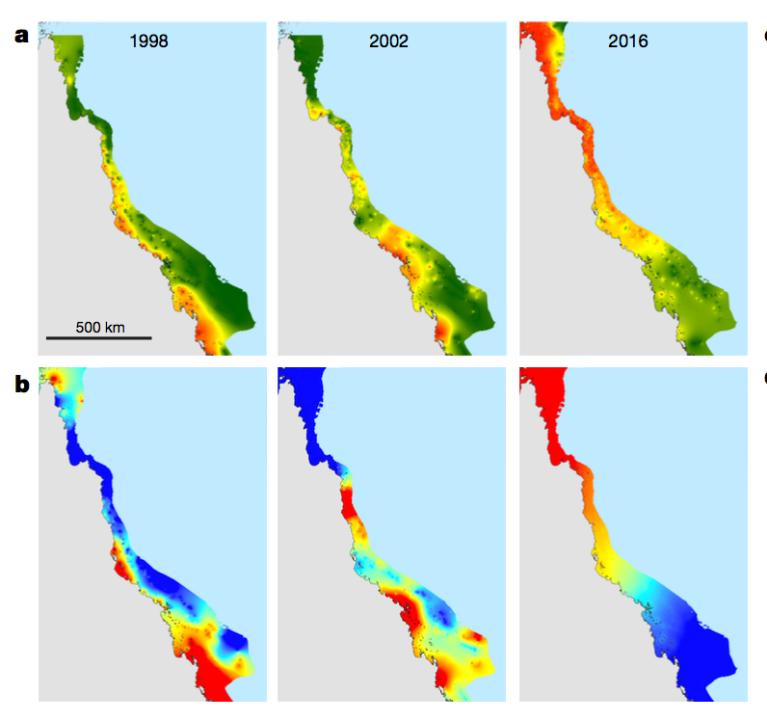 (a) measured by extensive aerial surveys with dive-based ground truth validation: dark green (<1% of corals bleached), light green (1–10%), yellow (10–30%), orange (30–60%), red (>60%). The number of reefs surveyed in each year was 638 (1998), 631 (2002), and 1,156 (2016)
(a) measured by extensive aerial surveys with dive-based ground truth validation: dark green (<1% of corals bleached), light green (1–10%), yellow (10–30%), orange (30–60%), red (>60%). The number of reefs surveyed in each year was 638 (1998), 631 (2002), and 1,156 (2016)
(b) Spatial pattern of heat stress (DHWs or degree heating weeks; °C-weeks) during each mass-bleaching event. Dark blue indicates 0 DHW, and red is the maximum DHW for each year (7, 10 and 16, respectively). Orange and yellow indicate intermediate levels of heat exposure on a continuous scale.
Returning to discussion of our cultural backlash, evidence like this obviously makes it hard to ignore the relationship of coral impact to ocean warming. This can tempt contrarians to retreat back to more generic rejection of anthropogenic warming itself (of course, a longstanding cottage industry of its own.)
In our contrarian article, Jessop offers a closing swipe of this sort, pretty typical of the genre. We’re offered a frequently circulated ISCCP chart that is claimed to show that global warming is due to some hypothesized tropical decline in cloud cover (mysteriously, amid generally rising tropospheric humidity).
The owners of this ISCCP data set unsurprisingly insist their data set provides no evidence of any such thing, as noted on the web page where the data is accessed, but the chart is what is described as a “zombie claim” in the climate propaganda wars. One more correction will doubtless not deter further recirculation, but for the record there is Evan et al 2007, “Arguments against a physical long-term trend in global ISCCP cloud amounts”:
Here we show that trends observed in the ISCCP data are satellite viewing geometry artifacts and are not related to physical changes in the atmosphere.
Observations of increasing ocean heat continue to pretty exactly match mean predictions derived from mainstream understanding of earth’s energy budget and the continually-validated greenhouse effect. This is really the core test of AGW theory – it derives from the notion of conservation of energy, the balance between incoming (solar, “shortwave”) and outgoing (infrared or “longwave”) radiation mediated by the planet’s ability to store or release energy in/from the ocean.
For example this article from Lijing, Jiang and Abraham 2015, “Global Upper Ocean Heat Content Estimation: Recent Progress and the Remaining Challenges”, or this summary graphic from NASA’s climate director highlighting the close match between model simulations and ocean heat content estimates and measurements (the quality of measurements increasing after 2000 with the deployment of ARGO):
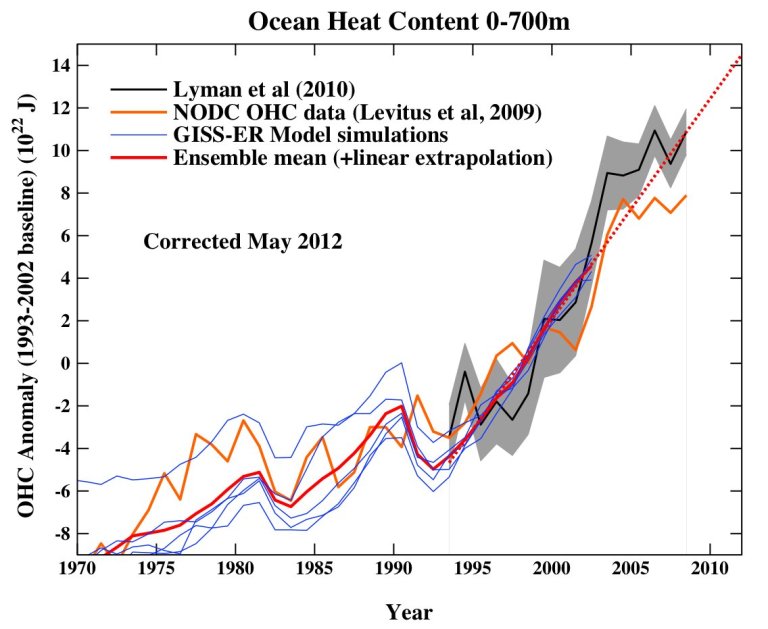
The short summary is that the evidence for greenhouse-driven warming of the oceans is strong (and obviously goes far beyond the above). The evidence for heat-induced mass mortality of corals is also extremely strong – spatial patterns of sustained heat and bleaching severity line up quite exactly, with well-understood biological mechanisms. Jessop’s article (and hundreds of others like it) don’t offer anything to dispute either of these things.
But Coral Have Been Around a Long Time
The main remaining argument, frequently raised, is a history-based argument from incredulity, per Jessop’s pasted tweet: “Corals have been around for, like, 250 million years and survived several major global extinction events”. Maybe coral are just inherently resilient, have faced such threats many times before and will quickly adapt?
This for example is the argument championed by Australia’s resident contrarian scientist (and marine dredging expert) Peter Ridd, quickly rising in popularity on partisan media. “Mass bleaching events are … almost certainly completely natural,” says Ridd. “There is perhaps no ecosystem on Earth better able to cope with rising temperatures than the Great Barrier Reef.”
Looking at the record, paleoecological (fossil/proxy) studies on the Great Barrier Reef can find “remarkable long-term stability in coral community structure” but also evidence of past bleaching, if not as frequent or widespread.
Biologically there is plenty of uncertainty about the extent of different coral species’ ability to migrate, adapt and survive. Some species are more resilient than others (and are naturally the ones with a greater chance of survival.) But pace of change and degree of stress are always key in these questions, as highlighted in the paper Hoegh-Guldberg 2012, “The adaptation of coral reefs to climate change: Is the Red Queen being outpaced?”
Coral reefs have enormous value in terms of biodiversity and the ecosystem goods and services that they provide to hundreds of millions of people around the world. These important ecosystems are facing rapidly increasing pressure from climate change, particularly ocean warming and acidification. A centrally important question is whether reefbuilding corals and the ecosystems they build will be able to acclimate, adapt, or migrate in response to rapid anthropogenic climate change. This issue is explored in the context of the current environmental change, which is largely unprecedented in rate and scale and which are exceeding the capacity of coral reef ecosystems to maintain their contribution to human wellbeing through evolutionary and ecological processes. On the balance of evidence, the ‘Red Queen’ (an analogy previously used by evolutionary biologists) is clearly being ‘left in the dust’ with evolutionary processes that are largely unable to maintain the status quo of coral reef ecosystems under the current high rates of anthropogenic climate change.
A recent paper Bay et al 2017 looks at evolutionary adaptation relative to current warming trends and finds the hopeful note that “Genomic models predict successful coral adaptation if future ocean warming rates are reduced”. Of course, reduced warming rates are not what are expected in the wake of currently rising emission levels, so the paper concludes similar to Frieler above:
Under more severe scenarios, RCP6.0 and RCP8.5, adaptation was not rapid enough to prevent extinction.
As a result the reasons for alarm remain quite clear. Looking further back in geologic history you can find multiple reef gaps after extreme climate and extinction events, sometimes millions of years long (with ocean acidification particularly implicated in sustained reef gaps). The coral species of today are quite different from those that were around say 250 million years ago. In particular, they did not actually survive the Permian extinction at that time.
Appropriate historical comparisons with current rates of climate change are tricky to even find. Anthropogenic warming appears very abrupt in geologic terms. The current human-driven rate of carbon release looks about 10x as fast as the nearest comparison, ~66 million years ago at the Paleocene–Eocene Thermal Maximum (PETM). The significant marine disruption at the PETM event was associated with numerous extinctions, and “coral reefs suffered heavily during this ‘mini-extinction’ and most disappeared”.
(Some additional, interesting historical perspective is offered in the book A Reef in Time, The Great Barrier Reef from Beginning to End, by J.E.N. Veron, former chief scientist at the Australian Institute of Marine Science.)
All things considered, remember we are directly observing mass coral death. If coral reefs have some superpower that prevents them from dying off under aggressively changing climate conditions, we haven’t seen it yet. The reef cover trend is sharply down over time (exacerbated by multiple stressors.)
The key point is that the economic and biodiversity value of reefs scales with cover, not survival. Meaning it is how much reef we have that matters in terms of benefit to the oceans and to us. Large loss of biodiversity is expected (already detectable in dependent fish species), but some species absolutely may find niches and hang on, migrating on currents to cooler locales for example. But it takes centuries or millennia to rebuild reefs that fuel ocean wildlife and food sources on the scale of our existing giant tropical reefs – time that passes very slowly on human calendars. And this hypothetical future rebuilding of reefs is dependent both on climate actually stabilizing (no sign of this in the coming century) and the ability of coral to productively rebuild calcium carbonate reefs, where they face the parallel growing threat of shifts in ocean chemistry (acidification).
There are always open questions – climate, biochemistry and biodiversity are all complex. But smug complacency, to be blunt, can only be described as shocking collective madness at this point. Coral death is directly observed, not theoretical. The impact and risk are stark.
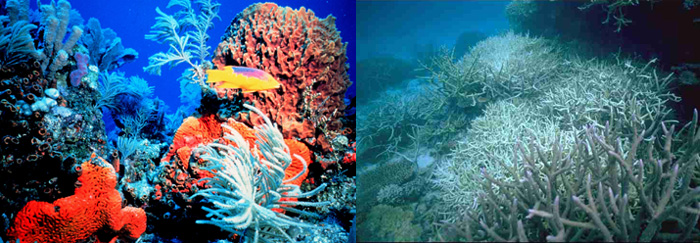
For extensive interesting comments, see the ATTP link (preceding comment) where this article was re-blogged.
Example of a comment from a geologist discussing ecological value of reefs:
https://andthentheresphysics.wordpress.com/2019/03/05/guest-post-on-coral-alarmism/#comment-147359
LikeLike